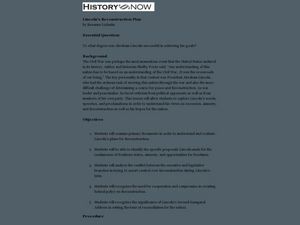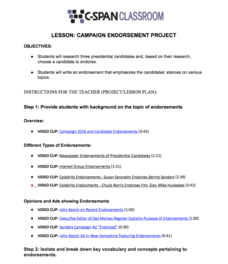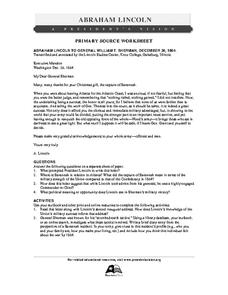Curated OER
George Washington and the Rule of Law
students compare The rule of law with the rule of men and consider life under each of these types of governments.In this government instructional activity, students read a primary source to examine the importance of the rule of law.They...
K12 Reader
Branches of Government
Set down the basics of the three branches of government with the reading passage included here. After reading, class members answer five questions related to the passage.
Judicial Learning Center
About Federal Judges
Not just anybody can do the job of a federal judge, but according to the United States Constitution just about anybody can be appointed. The lesson outlines the process and requirements for becoming a federal judge, focusing on the...
Curated OER
Lincoln's Spot Resolutions
Students take a closer look at historical relations between the United States and Mexico. In this Texas annexation lesson, students examine primary documents authored by Zachary Taylor, James Polk, and Abraham Lincoln to consider why the...
American Constitution Society
Constitution in the Classroom: The Right to Vote
The system of checks and balances is integral to the functionality of the United States government. Learn more about the ways the three branches of the government work together—and about the limitations of their power—with an informative...
National Endowment for the Humanities
The 1828 Campaign of Andrew Jackson: Changes in Voting Participation
Students give examples to indicate how voting participation changed in the first half of the 19th century, and make connections between changes in voting participation and the results of the election of 1828.
National Endowment for the Humanities
The 1828 Campaign of Andrew Jackson: Expansion of the Voting Base
Students give examples to indicate how the franchise was extended and limited in the first half of the 19th century, and cite some differences in the newly enfranchised population that could affect the way they would vote.
Curated OER
Lincoln's Reconstruction Plan
Young scholars explore Lincoln's Reconstruction plan. In this Reconstruction lesson, students examine Lincoln's speeches and writings on bringing the country back together following the war.
Curated OER
The American Revolution: 1775-1783
Casting the American Revolution into a bright, informative light, this presentation details many key facts about the strategies and decision during the revolutionary campaigns. The latter half of the slides prompt viewers to examine why...
Curated OER
The Civil War (1861-1865) Through Maps, Charts, Graphs, & Pictures
True to its titles, this engaging and appealing presentation brings the 1860's into close focus with a number of images and statistics that would delight any Civil War buff. A few graphs allow for pupil input, such as listing the...
Curated OER
The Kennedys: An American Camelot?
A life in pictures makes sense for a frontline public family like the Kennedys. Slides depict the parents and each sibling as successful, sad, or tragic. The initial slide provides two web links for information to go along with the images.
C-SPAN
Campaign Endorsement Project
So many politicians, so many endorsements! Learn to differentiate between facts as well as the process of endorsements with an informative resource. Class members watch current endorsement videos, research candidates from three different...
Curated OER
Informal Amendment
Informal Constitutional amendments are the focus of this review worksheet, which covers the circumstances and methods by which Congress may informally amend the Constitution. The format of this worksheet would lend well to a homework...
Curated OER
Constitution Basics and Political Spectrum
Have learners try their hands at an online quiz. There are 32 multiple choice questions all related to the three branches of the US government. Questions regarding US economics are also included.
Curated OER
The Myth of Voluntary Internment
Students review the Alien Enemies Act and Executive Order 9095. They explore both the financial and emotional ramifications of having a parent arrested or interned. They research what daily life was like in U.S. Internment camps during...
Curated OER
Scooting Away from Justice?
Learners examine President Bush's July 2007, decision to commute the 30-month sentence of former White House official, I. Lewis 'Scooter' Libby by reading a New York Times article. They scan editorial sources on various sides of the...
Curated OER
Term Limits: When is Enough?
Students discuss the issue of term limits in the executive and legislative branches. They research the issue and create a pros and cons chart with the various opinions on Congressional term limits. In addition, they explore the 22nd...
Curated OER
And Justice For All
Learners compare three justice systems currently in place in the United States: the civilian criminal justice system, the military criminal justice system (courts-martial) and the secret wartime tribunals that President Bush has proposed...
Curated OER
Keeping an Appointment
Students studey about Bernard B. Kerik's decision to withdraw his nomination as homeland security secretary by President Bush. They hold a mock vetting process for other potential nominees for this position.
Curated OER
Cartoons for the Classroom: Drawing a Bead on the Wall Street Rats
In this current events worksheet, learners analyze a political cartoon about Wall Street executive bonuses and respond to 3 talking point questions.
Curated OER
The Power of an MP versus Their Loyalties to the Cabinet and Caucus
High schoolers analyze the benefits and drawbacks that the government MP faces belonging to a party caucus and their association with a powerful executive in the cabinet.
Student Handouts
The Emancipation Proclamation
Start your class on the Emancipation Proclamation. The entire text of the Proclamation is included here along with two questions to answer. Space is provided to allow pupils to write their responses right on the page. Use this as a quick...
Humanities Texas
Primary Source Worksheet: Abraham Lincoln, Letter to General William T. Sherman
A brief letter can speak volumes. Your young historians will analyze a letter written by Abraham Lincoln to General Sherman, and discover the significance of the capture of Savannah, as well as gain insight into Lincoln's role as...
DocsTeach
Court Packing vs. Reorganizing: The Supreme Court in the New Deal
Travel back in time to understand the effects of FDR's New Deal on the Supreme Court. Academics analyze historical documents to understand FDR's attempts to pack the Supreme Court and the opposition he faced. The activity includes a...

























